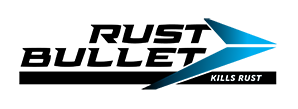• Rust Bullet is a moisture cured urethane which means it is sensitive to moisture. This provides strong adhesive properties and durability but requires careful attention when handling and during application. The surface to be coated must be completely dry before, during, and after application to avoid potential failure. Ideally, keep the surface dry for at least 72 hours after application to allow a full cure before exposure to moisture.
• Never allow sweat, rain, mist or other contaminates to fall into a Rust Bullet coating. Even a drop or two can drastically affect results.
• Rust Bullet coatings require a surface profile for proper adhesion. The use of Rust Bullet Metal Blast for metal applications will etch the metal surface and provide the ideal anchor pattern to surfaces allowing superior adhesion of Rust Bullet coatings. Concrete applications require a Concrete Surface Profile (CSP) of 1 which is equivalent to about 120 grit sandpaper in texture and can be achieved by sanding with 60-80 grit sandpaper when needed.
• Rust Bullet coatings are ready to use right from the can. Thinning is not necessary. Adjust the application equipment as opposed to adjusting the coating.
• Rust Bullet coatings should be stirred thoroughly by hand for at least three minutes until homogenous. Do not shake the can or use mechanical means to mix. Avoid creating air bubbles in the coating during mixing.
• Only pour out what you intend to use in one hour and quickly re-seal the can. Wipe clean any coating from the rim of the container before resealing.
• Use Bloxygen to keep any leftover product from curing for up to six months. Bloxygen is an inert Argon gas that will displace the oxygen and provide a much longer storage life for unused portions of previously opened containers.
• Rust Bullet Solvent works best for cleanup, equipment prep, and thinning when needed. Do not use lacquer thinner, vinyl thinner, epoxy solvent, or any alcohol or unapproved solvent. If Rust Bullet Solvent is unavailable, Xylene, Toluene, or MEK may be substituted.
• When using spray equipment, flush Rust Bullet Solvent through pumps, lines, and guns prior to spraying to remove any existing moisture or other contaminates. Clean equipment immediately in between coats and when finished spraying to avoid product curing inside of the spray equipment.
• Apply it in thin, even coats. Thick coats will cause bubbling, also known as solvent popping, and eventually a coating failure.
• The optimum recoat time is between two to six hours, up to 12 hours. Touch the surface with a gloved finger about two hours after your last coat. If you have no transfer of paint, you are ready for your next coat. If 12 or more hours have lapsed, wait for the last coat to cure for at least 24 hours, then lightly scuff with 80-100 grit; enough to break the glaze to create a surface profile.
